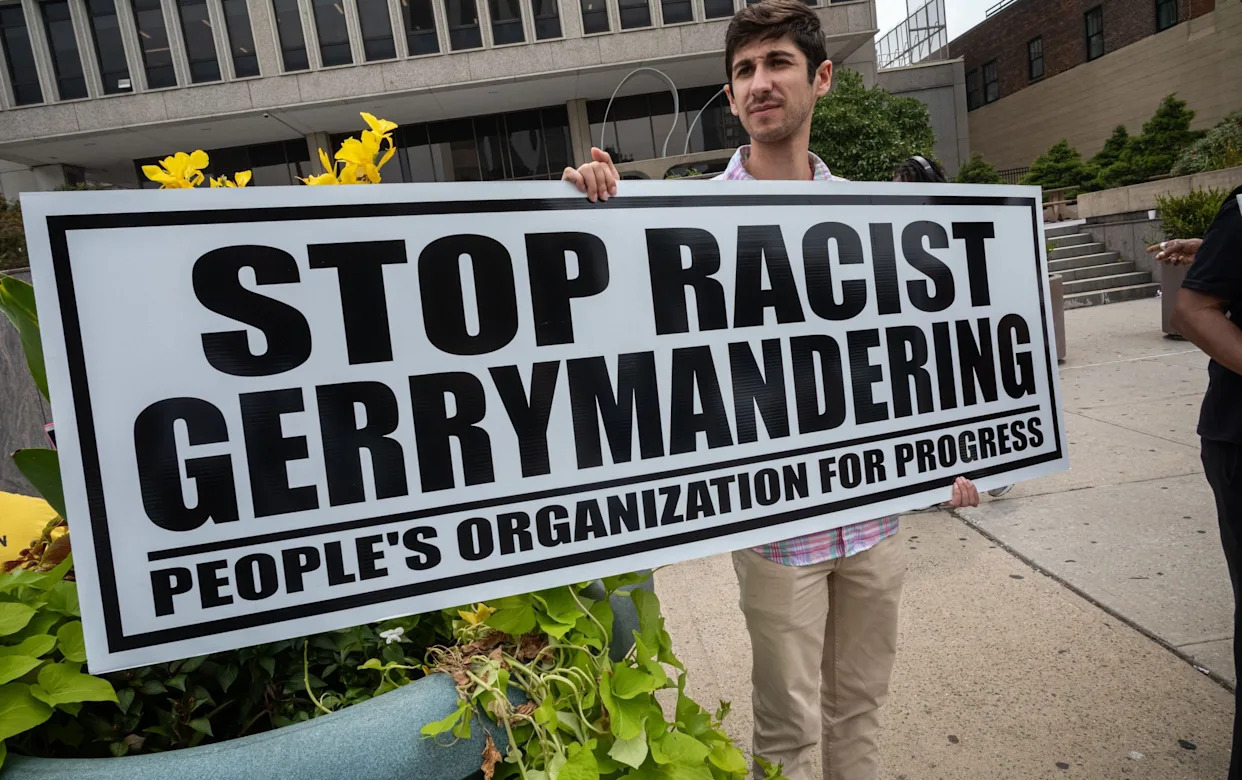
Is the US Supreme Court about to disenfranchise black Americans and other racial minority voters? You would think so, given the hysterical hyperbole found in the progressive press. In the New York Times, Jamelle Bouie claims that the Supreme Court is seeking to make the Voting Rights Act of 1965 – legislation that prohibits racial discrimination in the electoral process – “an artefact of the past”.
“The Supreme Court Prepares to End Voting Rights As We Know Them,” shrieks the headline in the Left-wing journal Mother Jones.
“Sixty years ago, the Voting Rights Act ended the Jim Crow regime and transformed the country, finally, into a multiracial democracy – albeit an imperfect one,” the Mother Jones article reads. “But, with the court’s quiet announcement it would return to a paused case, the justices are now preparing to take us back to a time when elected officials at all levels of government were white, and the rights of minorities were trampled.”
Is the Republican majority on the Supreme Court really about to strike down or eviscerate the Voting Rights Act of 1965? Will the Court legalise the outlawed methods used by Southern segregationists to deny the right to vote to black Americans, like literacy tests and poll taxes?
Of course not. The occasion of these alarms is the willingness of the Court to consider a Louisiana case involving the use of race by state legislatures in drawing congressional districts.
What is at issue is the question of whether the half-century-old practice of racial gerrymandering – drawing congressional districts in such a way as to elect representatives of a particular race to the House of Representatives – is compatible with the Voting Rights Act or the US constitution.
Partisan gerrymandering is almost as old as the United States. American states, not the federal government, draw the lines of districts that send representatives to the House of Representatives, and following the census every decade state legislatures redraw the lines to take into account population growth or decline. To increase the chances of electing members of their own party, state legislators often draw bizarrely-shaped districts, with extensions bypassing members of the rival party to loop in likely supporters of their own party.
The term “gerrymander” originated in the early 19th century with this kind of cynical partisan congressional redistricting. In 1812, the Massachusetts legislature drew a district which, according to critics, resembled a salamander. Although Governor Elbridge Gerry, a signer of the Declaration of Independence, accepted the redistricting plan reluctantly, claiming it was “highly disagreeable”, the contorted district was named a “Gerry-mander” in his dubious honour.
Partisan gerrymandering by state legislatures still exists. Democratic and Republican majorities in every state legislature, following each federal census, seek to draw congressional districts that will boost their party’s representation in the national House of Representatives.
Racial gerrymandering, however, arose in the aftermath of the civil rights revolution of the 1960s. In racial gerrymandering, congressional districts are drawn to maximise the likelihood that the representative who is elected to Congress will belong to a particular race, as defined by America’s arbitrary post-1970s system of official races: non-Hispanic whites, Hispanics, African Americans, Asian and Pacific Islanders, and native Americans.
To put it another way, racial gerrymandering is race-based affirmative action or DEI for non-white politicians, the corollary of the race-based quota system that reshaped college admissions and public, private, and nonprofit hiring, before the recent push-back led by President Trump and Supreme Court conservatives. Both kinds of affirmative action have always betrayed not only the spirit but also the letter of actual civil rights statutes. Title VII of the Civil Rights Act, for example, makes it illegal for employers or labour unions “To discriminate against, any individual because of his race, colour, religion, sex, or national origin”.
The language of the Voting Rights Act of 1965 is equally colour-blind, emphasising the rights of minority voters to vote as they choose for politicians of any race, not the desire of minority politicians to enjoy rigged congressional seats:
“A violation of [the Act] is established if, based on the totality of circumstances, it is shown that the political processes leading to nomination or election in the State or political subdivision are not equally open to participation by members of a class of citizens protected by subsection (a) in that its members have less opportunity than other members of the electorate to participate in the political process and to elect representatives of their choice. The extent to which members of a protected class have been elected to office in the State or political subdivision is one circumstance which may be considered: Provided, That nothing in this section establishes a right to have members of a protected class elected in numbers equal to their proportion in the population. [emphasis added].”
While the complete absence of any elected officials belonging to racial minorities might well be evidence of a violation of the law, the Voting Rights Act does not create a right for minority politicians to have districts drawn to give them safe seats. As in the case of race-based affirmative action in general, racial gerrymandering has been practised for more than half a century in defiance of the plain language of the law.
Ironically, conservative Republicans in the South teamed up with black Democrats in support of racial gerrymandering for their own selfish reasons, beginning in the 1970s. Some Republican legislatures used a strategy of “packing” – drawing lines to pack black voters into black-majority districts, while trapping white Democrats as powerless partisan minorities in Republican-majority districts.
At the same time, some activists sacrificed the interests of the Democratic Party in winning congressional majorities to the goal of electing as many black Democrats in safe, gerrymandered districts as possible. When I worked for a white liberal Democrat in the Texas legislature in the 1970s, I was told that Texas Republicans had donated large sums of money to black legislators and activists to help them draw black-majority districts.
The Democratic Party soon suffered as a result of racial gerrymandering, in Texas and in the House of Representatives. Thanks to racial gerrymandering as well as partisan gerrymandering, Republicans have dominated both houses of the Texas legislature since 2003, freezing out Texas Democrats.
In the mid-term elections of 1994, Republicans led by Newt Gingrich recaptured the US House of Representatives for the first time since the 1950s. Not a single black Democrat lost in that election, thanks to their safe districts. But the loss of seven seats held by white Democrats thanks to racial gerrymandering gave Republicans the majority. At the time, David Bositis of the Joint Centre for Political and Economic Studies declared: “Over the last two elections, the Democrats have lost as many as 15 seats because of majority black redistricting.”
Without the loss of those seats, Democrats would have retained the House in 1994 by a margin of 218-216 and Gingrich would have been the frustrated House Minority Leader, not the Speaker of the House.
Racial gerrymandering, then, might serve the interests of minority politicians but not necessarily the interests of minority voters. Presumably most black Democrats in 1994 would have preferred to have fewer black Democratic representatives in a House with a Democratic majority instead of more black representatives in a Democratic Party that had lost control of the House.
Racial gerrymandering gained some credibility from the extreme racial polarisation along party lines in the immediate aftermath of desegregation half a century ago. Progressive propaganda to the contrary, however, the American electorate is far less polarised by race in the 2020s than ever before.
In terms of partisan polarisation, black voters are outliers in the American electorate. In 1994, 86 per cent of black registered voters were Democrats, according to Pew; in 2024, the number was 83 per cent. Hispanic voters (61 per cent Democrat, 35 per cent Republican) and Asian-American voters (63-35) also prefer Democrats but by much smaller margins. And white Americans have long been the least racially-polarised group in the electorate, preferring Republicans by 55-42 per cent in 1994 and 56-41 per cent in 2024.
These numbers fail to completely register the decline of racial polarisation, however, with Hispanic and black voters shifting toward Republicans in recent elections. And they do not show the growing trend of class polarisation between college graduates and those without college degrees.
What is more, the very categories on which affirmative action in congressional redistricting and other areas rests are rapidly being eroded by intermarriage, now that one in six American newly-weds are estimated by Pew to have a spouse of another race.
The federal courts should continue to enforce the law against attempts by federal, state and local governments to deprive individual Americans, of any race, of the right to vote. But individual Americans surely do not have to be represented in Congress by a member of their own race as long as the candidates of the party for whom they vote represent their personal views and values.
Let us hope the Supreme Court will vindicate the original mission of the Voting Rights Act of eliminating barriers to voting by individuals, as opposed to setting up racially-gerrymandered safe seats for a few politicians.
Michael Lind is a fellow at New America and the author of ‘Hell to Pay: How the Suppression of Wages Is Destroying America’








Comments